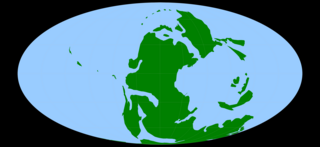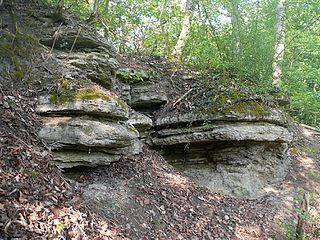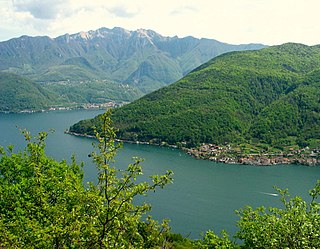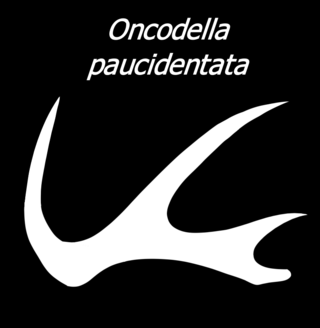
The Permian is a geologic period and stratigraphic system which spans 47 million years from the end of the Carboniferous Period 298.9 million years ago (Mya), to the beginning of the Triassic Period 251.902 Mya. It is the last period of the Paleozoic Era; the following Triassic Period belongs to the Mesozoic Era. The concept of the Permian was introduced in 1841 by geologist Sir Roderick Murchison, who named it after the region of Perm in Russia.

Conodonts are an extinct group of agnathan (jawless) vertebrates resembling eels, classified in the class Conodonta. For many years, they were known only from their tooth-like oral elements, which are usually found in isolation and are now called conodont elements. Knowledge about soft tissues remains limited. They existed in the world's oceans for over 300 million years, from the Cambrian to the beginning of the Jurassic. Conodont elements are widely used as index fossils, fossils used to define and identify geological periods.

Agnatha is an infraphylum of jawless fish in the phylum Chordata, subphylum Vertebrata, consisting of both living (cyclostomes) and extinct species. Among recent animals, cyclostomes are sister to all vertebrates with jaws, known as gnathostomes.
The Lopingian is the uppermost series/last epoch of the Permian. It is the last epoch of the Paleozoic. The Lopingian was preceded by the Guadalupian and followed by the Early Triassic.
The Rhaetian is the latest age of the Triassic Period or the uppermost stage of the Triassic System. It was preceded by the Norian and succeeded by the Hettangian. The base of the Rhaetian lacks a formal GSSP, though candidate sections include Steinbergkogel in Austria and Pignola-Abriola in Italy. The end of the Rhaetian is more well-defined. According to the current ICS system, the Rhaetian ended 201.4 ± 0.2 Ma.

In the geologic timescale, the Anisian is the lower stage or earliest age of the Middle Triassic series or epoch and lasted from 247.2 million years ago until 242 million years ago. The Anisian Age succeeds the Olenekian Age and precedes the Ladinian Age.

The Carnian is the lowermost stage of the Upper Triassic Series. It lasted from 237 to 227 million years ago (Ma). The Carnian is preceded by the Ladinian and is followed by the Norian. Its boundaries are not characterized by major extinctions or biotic turnovers, but a climatic event occurred during the Carnian and seems to be associated with important extinctions or biotic radiations. Another extinction occurred at the Carnian-Norian boundary, ending the Carnian age.

The Early Triassic is the first of three epochs of the Triassic Period of the geologic timescale. It spans the time between 251.9 Ma and 247.2 Ma. Rocks from this epoch are collectively known as the Lower Triassic Series, which is a unit in chronostratigraphy. The Early Triassic is the oldest epoch of the Mesozoic Era. It is preceded by the Lopingian Epoch and followed by the Middle Triassic Epoch. The Early Triassic is divided into the Induan and Olenekian ages. The Induan is subdivided into the Griesbachian and Dienerian subages and the Olenekian is subdivided into the Smithian and Spathian subages.

In the geologic timescale, the Olenekian is an age in the Early Triassic epoch; in chronostratigraphy, it is a stage in the Lower Triassic series. It spans the time between 251.2 Ma and 247.2 Ma. The Olenekian is sometimes divided into the Smithian and the Spathian subages or substages. The Olenekian follows the Induan and is followed by the Anisian.
The Late Triassic is the third and final epoch of the Triassic Period in the geologic time scale, spanning the time between 237 Ma and 201.4 Ma. It is preceded by the Middle Triassic Epoch and followed by the Early Jurassic Epoch. The corresponding series of rock beds is known as the Upper Triassic. The Late Triassic is divided into the Carnian, Norian and Rhaetian ages.

The Induan is the first age of the Early Triassic epoch in the geologic timescale, or the lowest stage of the Lower Triassic series in chronostratigraphy. It spans the time between 251.9 Ma and 251.2 Ma. The Induan is sometimes divided into the Griesbachian and the Dienerian subages or substages. The Induan is preceded by the Changhsingian and is followed by the Olenekian.

The Ladinian is a stage and age in the Middle Triassic series or epoch. It spans the time between 242 Ma and ~237 Ma. The Ladinian was preceded by the Anisian and succeeded by the Carnian.
The Norian is a division of the Triassic Period. It has the rank of an age (geochronology) or stage (chronostratigraphy). It lasted from ~227 to 208.5 million years ago. It was preceded by the Carnian and succeeded by the Rhaetian.
Metapolygnathus is an extinct genus of platform conodonts.
Carnepigondolella is an extinct genus of conodonts of the Late Triassic of Italy or Canada.
Mazzaella is an extinct genus of Late Triassic ozarkodinid conodonts in the family Gondolellidae. They are found in mid-Julian sediments of the Tethys Ocean, including strata in Europe and Turkey.
The Pignola-Abriola section is a ~63 m long stratigraphic sequence of cherty limestones deposited in the Lagonegro Basin during the latest Norian and the early Rhaetian Stages. The main outcrop is on the western side of Mount Crocetta along the SP5 road connecting the villages of Pignola and Abriola. A smaller outcrop, overlapping the central part of the main section, is located near a former railway tunnel, few meters below the road level. The Pignola-Abriola section has been recently proposed as GSSP of the Rhaetian Stage.

Oncodella is an extinct genus of Late Triassic conodont. The genus was given the type species Oncodella idiodentica by Mosher (1968), on the basis of fossils from the Late Triassic of Austria. However, Mosher (1969) later revised the species name to Oncodella paucidentata, since identical fossils from the same area were previously given the name Hindeodella paucidentata by Mostler (1967).
Mockina is an extinct genus of Late Triassic conodonts. Several species of Mockina are used as index fossils for the Alaunian and Sevatian substages of the Triassic. One species, Mockina bidentata, is considered to be ancestral to Misikella and Parvigondolella, some of the last known genera of conodonts. Mockina has occasionally been synonymized with Epigondolella based on the assumption that it represents Epigondolella specimens which live in resource-poor environments. Mockina/Epigondolella multidentata has occasionally been considered to belong to its own genus, Orchardella.
Parvigondolella is an extinct genus of Late Triassic conodonts. The most common species in the genus, Parvigondolella andrusovi, is used as an index fossil for part of the Sevatian substage of the Norian stage. Kozur & Mock, 1991 named two additional species, P. rhaetica and P. vrielyncki. Moix et al. (2007) later argued that "Misikella" rhaetica was a species of Parvigondolella. In order to prevent having two different species with the same name within the genus, they renamed Kozur & Mock (1991)'s P. rhaetica to P. prorhaetica. However, this would be unnecessary if "Misikella" rhaetica was not related to Parvigondolella. Parvigondolella is typically considered a direct descendant of Mockina/Epigondolella bidentata.









